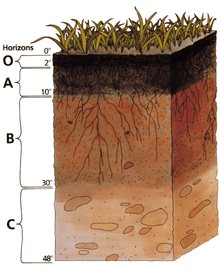Soil salinity
Soil salinity is the salt content in the soil; the process of increasing the salt content is known as salinization.[1] Salts occur naturally within soils and water. Salination can be caused by natural processes such as mineral weathering or by the gradual withdrawal of an ocean. It can also come about through artificial processes such as irrigation and road salt.
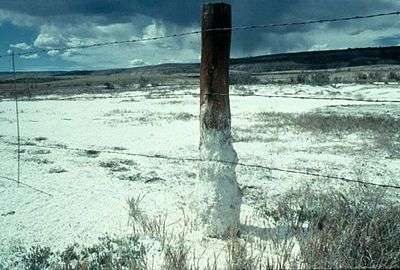

Natural occurrence
Salts are a natural component in soils and water.
The ions responsible for salination are: Na+, K+, Ca2+, Mg2+ and Cl−.
Over long periods of time, as soil minerals weather and release salts, these salts are flushed or leached out of the soil by drainage water in areas with sufficient precipitation. In addition to mineral weathering, salts are also deposited via dust and precipitation. Salts may accumulate in dry regions, leading to naturally saline soils. This is the case, for example, in large parts of Australia.
Human practices can increase the salinity of soils by the addition of salts in irrigation water. Proper irrigation management can prevent salt accumulation by providing adequate drainage water to leach added salts from the soil. Disrupting drainage patterns that provide leaching can also result in salt accumulations. An example of this occurred in Egypt in 1970 when the Aswan High Dam was built. The change in the level of ground water before the construction had enabled soil erosion, which led to high concentration of salts in the water table. After the construction, the continuous high level of the water table led to the salination of the arable land.
Sodic soils
When the Na+ (sodium) predominates, soils can become sodic. The pH of sodic soils may be acidic, neutral or alkaline.
Sodic soils present particular challenges because they tend to have very poor structure which limits or prevents water infiltration and drainage. They tend to accumulate certain elements like boron and molybdenum in the root zone at levels that maybe toxic for plants.[2] The most common compound used for reclamation of sodic soil is gypsum, and some plants that are tolerant to salt and ion toxicity may present strategies for improvement.[3]
The term "sodic soil" is sometimes used imprecisely in scholarship. It's been used interchangeably with the term alkali soil, which is used in two meanings: 1) a soil with a pH greater than 8.2, 2) a soil with an exchangeable sodium content in excess of 15% of exchange capacity. The term "alkali soil" is often, but not always, used for soils that meet both of these characteristics.[4]
Dry land salinity
Salinity in drylands can occur when the water table is between two and three metres from the surface of the soil. The salts from the groundwater are raised by capillary action to the surface of the soil. This occurs when groundwater is saline (which is true in many areas), and is favored by land use practices allowing more rainwater to enter the aquifer than it could accommodate. For example, the clearing of trees for agriculture is a major reason for dryland salinity in some areas, since deep rooting of trees has been replaced by shallow rooting of annual crops.
Salinity due to irrigation

Salinity from irrigation can occur over time wherever irrigation occurs, since almost all water (even natural rainfall) contains some dissolved salts.[5] When the plants use the water, the salts are left behind in the soil and eventually begin to accumulate. Since soil salinity makes it more difficult for plants to absorb soil moisture, these salts must be leached out of the plant root zone by applying additional water. This water in excess of plant needs is called the leaching fraction. Salination from irrigation water is also greatly increased by poor drainage and use of saline water for irrigating agricultural crops.
Salinity in urban areas often results from the combination of irrigation and groundwater processes. Irrigation is also now common in cities (gardens and recreation areas).
Consequences of soil salinity
The consequences of salinity are
- Detrimental effects on plant growth and yield
- Damage to infrastructure (roads, bricks, corrosion of pipes and cables)
- Reduction of water quality for users, sedimentation problems, increased leaching of metals,[6] especially copper, cadmium, manganese and zinc.
- soil erosion ultimately, when crops are too strongly affected by the amounts of salts.
- More energy required to desalinate
Salinity is an important land degradation problem. Soil salinity can be reduced by leaching soluble salts out of soil with excess irrigation water. Soil salinity control involves watertable control and flushing in combination with tile drainage or another form of subsurface drainage.[7][8] A comprehensive treatment of soil salinity is available from the United Nations Food and Agriculture Organization.[9]
Salt tolerance of crops
High levels of soil salinity can be tolerated if salt-tolerant plants are grown. Sensitive crops lose their vigor already in slightly saline soils, most crops are negatively affected by (moderately) saline soils, and only salinity-resistant crops thrive in severely saline soils. The University of Wyoming [10] and the Government of Alberta [11] report data on the salt tolerance of plants.
Field data in irrigated lands, under farmers' conditions, are scarce, especially in developing countries. However, some on-farm surveys have been made in Egypt,[12] India,[13] and Pakistan.[14] Some examples are shown in the following gallery, with crops arranged from sensitive to very tolerant.[15] [16]
- Graphs of crop yield and soil salinity in farmers' fields ordered by increasing salt tolerance.
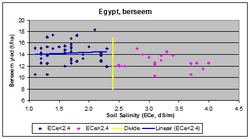 Fig. 1. Berseem (clover), cultivated in Egypt's Nile Delta, is a salt-sensitive crop and tolerates an ECe value up to 2.4 dS/m, whereafter yields start to decline.
Fig. 1. Berseem (clover), cultivated in Egypt's Nile Delta, is a salt-sensitive crop and tolerates an ECe value up to 2.4 dS/m, whereafter yields start to decline.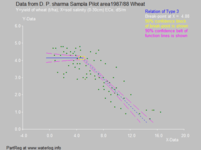 Fig. 2. Wheat grown in Sampla, Haryana, India, is slightly sensitive, tolerating an ECe value of 4.9 dS/m.
Fig. 2. Wheat grown in Sampla, Haryana, India, is slightly sensitive, tolerating an ECe value of 4.9 dS/m.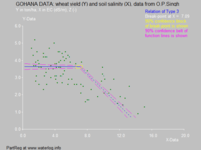 Fig. 3. The field measurements in wheat fields in Gohana, Haryana, India, showed a higher tolerance level of ECe = 7.1 dS/m.
Fig. 3. The field measurements in wheat fields in Gohana, Haryana, India, showed a higher tolerance level of ECe = 7.1 dS/m.
(The Egyptian wheat, not shown here, exhibited a tolerance point of 7.8 dS/m).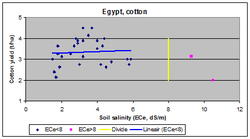 Fig. 4. The cotton grown in the Nile Delta can be called salt-tolerant, with a critical ECe value of 8.0 dS/m. However, due to scarcity of data beyond 8 dS/m, the maximum tolerance level cannot be precisely determined and may actually be higher than that.
Fig. 4. The cotton grown in the Nile Delta can be called salt-tolerant, with a critical ECe value of 8.0 dS/m. However, due to scarcity of data beyond 8 dS/m, the maximum tolerance level cannot be precisely determined and may actually be higher than that. Fig. 5. Sorghum from Khairpur, Pakistan, is quite tolerant; it grows well up to ECe = 10.5 dS/m.
Fig. 5. Sorghum from Khairpur, Pakistan, is quite tolerant; it grows well up to ECe = 10.5 dS/m. Fig. 6. Cotton from Khairpur, Pakistan, is very tolerant; it grows well up to ECe = 15.5 dS/m.
Fig. 6. Cotton from Khairpur, Pakistan, is very tolerant; it grows well up to ECe = 15.5 dS/m.
Regions affected
From the FAO/UNESCO Soil Map of the World the following salinised areas can be derived.[17]
| Region | Area (106 ha) |
|---|---|
| Africa | 69.5 |
| Near and Middle East | 53.1 |
| Asia and Far East | 19.5 |
| Latin America | 59.4 |
| Australia | 84.7 |
| North America | 16.0 |
| Europe | 20.7 |
See also
- Arabidopsis thaliana responses to salinity
- Salt tolerance of crops
- Desalination
- Environmental impacts of deicing salt
- Water softening
- U.S. Salinity Laboratory
- Salinity in Australia
References
- from "Soil salinity" in WaterWiki, the on-line Knowledge and Collaboration Tool of the Community of Practice (CoP) on Water- and UNDP-related activities in Central and South-Eastern Europe, Caucasus and Central Asia. Archived 2007-08-12 at the Wayback Machine
- 4. SODIC SOILS AND THEIR MANAGEMENT, FAO
- Encyclopedia of Soil Science. (2002). United States: Dekker.
- Genesis and Management of Sodic (Alkali) Soils. (2017). (n.p.): Scientific Publishers.
- ILRI (1989), Effectiveness and Social/Environmental Impacts of Irrigation Projects: a Review (PDF), In: Annual Report 1988 of the International Institute for Land Reclamation and Improvement (ILRI), Wageningen, The Netherlands, pp. 18–34
- "Saltier waterways are creating dangerous 'chemical cocktails'".
- Drainage Manual: A Guide to Integrating Plant, Soil, and Water Relationships for Drainage of Irrigated Lands, Interior Dept., Bureau of Reclamation, 1993, ISBN 978-0-16-061623-5
- "Free articles and software on drainage of waterlogged land and soil salinity control". Retrieved 2010-07-28.
- Salt-Affected Soils and their Management, FAO Soils Bulletin 39 (http://www.fao.org/docrep/x5871e/x5871e00.htm)
- Alan D. Blaylock, 1994, Soil Salinity and Salt tolerance of Horticultural and Landscape Plants. University of Wyoming Archived 2010-05-08 at the Wayback Machine
- Government of Alberta, Salt tolerance of Plants
-
- H.J. Nijland and S. El Guindy, Crop yields, watertable depth and soil salinity in the Nile Delta, Egypt. In: Annual report 1983. International Institute for Land Reclamation and Improvement (ILRI), Wageningen, The Netherlands.
- D. P. Sharma, K. N. Singh and K. V. G. K. Rao (1990), Crop Production and soil salinity: evaluation of field data from India. Paper published in Proceedings of the Symposium on Land Drainage for Salinity Control in Arid and Semi-Arid Regions, February, 25th to March 2nd, 1990, Cairo, Egypt, Vol. 3, Session V, p. 373–383. On line:
- R.J. Oosterbaan, Crop yields, soil salinity and water table depth in Pakistan. In: Annual Report 1981, pp. 50–54. International Institute for Land Reclamation and Improvement (ILRI), Wageningen, The Netherlands, reprinted in Indus 24 (1983) 2, pp. 29–33. On line
- Collection of salt tolerance data of agricultural crops from measurements in farmers' fields. On line:
- Crop Tolerance to Soil Salinity, Statistical Analysis of Data Measured in Farm Lands. In: International Journal of Agricultural Science, October 2018. On line:
- R. Brinkman, 1980. Saline and sodic soils. In: Land reclamation and water management, pp. 62–68. International Institute for Land Reclamation and Improvement (ILRI), Wageningen, The Netherlands.
